Posted by j.leboeuf
ABSTRACT
With the amount of problems faced today, it is a well-known fact by now that the world needs more designers. But even the existing designers do not know how to go about addressing these problems; as the notion of Social Design is a challenging one. With this growing need and interest and in the domains, there is a responsibility that designers have towards the society. This paper proposes a framework that could be used to teach Social Design as a part of the offerings of a Design course in Product Design or Service Design or independently. The example taken to illustrate the framework is a work in progress.
Author Keywords
Social Design; Wicked Problems; System Design; Methodology; Frameworks; Service Design; Design Education
Kshitiz Anand, Dean & Director
LÉcole de design Nantes Atlantique (India campus)
k.anand@lecolededesign.com
Jean Haag, Masters Student, Transcultural Design
LÉcole de design Nantes Atlantique
(India Campus)
jb.haag@lecolededesign.com
[Read more →]
Tags: · Design education, Frameworks, Methodology, Service design, Social design, System Design, Wicked problems
Posted by f.degouzon
Hughes Aubin is an tireless digital innovator, observing the impact of digital technologies on the society for years now. He mentored the project Identiscoop developed by Edouard Durand as final thesis work, a mobile application for a better control over one’s online digital identity. Hughes shares his reflection and experience, about extimacy or the subtle frontiers between what we hide, transform or exhibit from ourselves while being online…
Interview made by Grégoire Cliquet, course leader for the Virtual Reality Master’s program and head of the READi Design Lab, in october 2010.
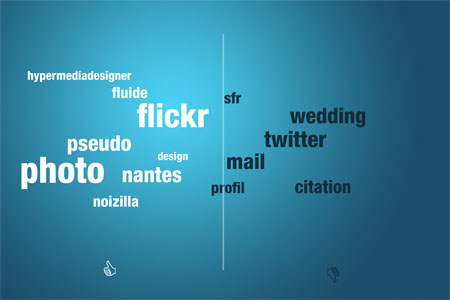
[Read more →]
Tags: · design, édouard durand, immersive environment, extimacy, facebook, google, grégoire cliquet, hughes aubin, identiscoop, identity, innovation, interaction, digital, virtual reality, social networks, second life, twitter, privacy, web 2.0
Posted by f.degouzon
How is it that a project-based activity resembling more a practice than a science and founded on empirical case studies manages to generate knowledge? How can research in design and research efforts on design conducted by scholars in other disciplines enrich each other? The current issue of CADI, our research journal, settles into the continuity of these reflections via three contributions pertaining to the topic of crossdisciplining.

Three complementary approaches from theory to practice… and vice versa
Jocelyne Le Bœuf*, Design Historian, sheds light on her specialty by referencing the major thought movements of which hers has become a part over history. She also addresses the current multidisciplinary research trends, and delves deeper into the role that design history plays not only in understanding our material environment, but also in designer practices.
Gilles Rougon, Design Manager at Électricité de France (EDF), elaborates upon design transversality within a company where the primary product is immaterial.
Eloi Le Mouël, Sociologist within the design department of the RATP (Paris City Transit Authority), underlines during an interview the similarities and differences between an anthropological approach with regard to “mobility flows” and the design project practice from his standpoint as a researcher in the field of social science.
*J. Le Bœuf is also Director of Studies at L’École de design Nantes Atlantique
The last printed edition… for a better visibility online
This issue will be a crucial step in the history of our research journal: it will be the last printed edition. From now on, essays, articles and interviews will be available online on this blog, with a fully bilingual content.
Read CADI Research Journal #2 on Scribd or download CADI in PDF format from our main corporate website.
Graphic design & layout: Audrey Templier & Yves Mestrallet for éditions MeMo
Tags: · codesign, design, edf, eloi le mouel, gilles rougon, histoire du design, innovation, jocelyne le boeuf, ratp, research
Posted by m.saysana
Not only is Guylaine Sauvaget Lasserre an Assistant Professor at the Psychology department of the University of Toulouse (south-western France), she has also dedicated herself to infant prevention and socialization for twenty years in a state-sponsored French institution. In 2009-2010 she thoroughly advised Master’s student in New Eating Habits Aurore Donnat in conducting her final degree project. Spurred by a strong interest in teenage anorexia Aurore elaborated Le réseau d’Arthur (Arthur’s Network) – an alternative solution to standard single-tray meals through eco-designed packaging. Her aim is to turn mealtimes into good times even for anorexic people.
Guylaine Sauvaget Lasserre was interviewed by Jean-Patrick Péché, Designer, Consultant and Head of the New Eating Habits research unit; their conversation hints at several key issues about design and its role in the food industry.
[Read more →]
Tags: · teenage, anorexia, workshop, aurore donnat, jean patrick péché, new eating habits, packaging, psychology
Posted by m.saysana
Thomas Buisson, a Master’s student in Responsible Innovation decided to put his know-how to use in upgrading the work conditions of firefighters. His initiative paved the way to a beautiful encounter between the young designer and Captain Jean-Baptiste Floch, appointed Head of the Carquefou Fire and Emergency Services in the vicinity of Nantes (Loire region). Benjamin Walker, Head of the Responsible Innovation research unit asked the firefighting officer a few questions about his collaboration with Thomas Buisson and his view on design.
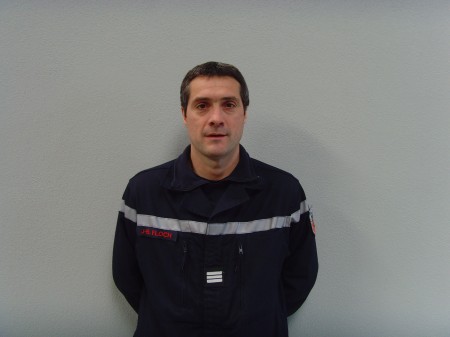
Jean-Baptiste Floch, Head of the Fire Department Services (Carquefou)
A very supportive tutor
BEN WALKER:
How did you react when Master’s student, Thomas Buisson, contacted you regarding his final degree project for L’École de design?
JEAN-BAPTISTE FLOCH:
My department had already been approached by students from L’École de design three or four years ago about a short-term, in-house mission at the fire station. The students had decided to center their research on the pull station, our alarm. We had agreed to take them in at the emergency unit, and this turned out to be a positive collaboration. So, when Thomas Buisson came to us in April 2008 with a long-term, broadly scoped project in mind, I listened to what he had to say, and decided to offer him the same opportunity at the local fire station so that my team and I could support him in his research.
BEN WALKER:
Wasn’t it a bit strange to have a designer within your team?
JEAN-BAPTISTE FLOCH:
It sure does not happen everyday. When I submitted Thomas’s internship paperwork to my bosses, the Deputy Director, puzzled, contacted me right away inquiring about what our fire brigade could possibly have to do with L’École de design. I made a point of explaining to him what Thomas had in mind and where he was headed to demonstrate not only his personal commitment, but how he was willing to upgrade our material with his design proposals. We agreed upon a type of tutorship that would not have too much impact on our budget and our tasks.
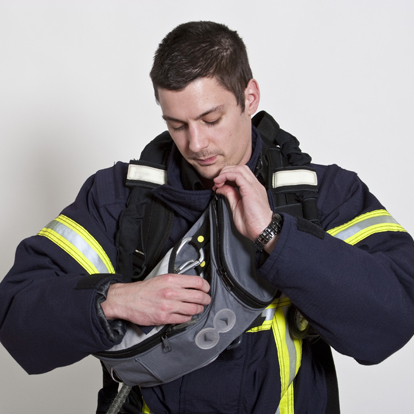
Fire Line - Thomas Buisson - 2010
BEN WALKER:
You had to explain to him that there was more to a designer’s role than purely decorative, but rather real and ever-evolving change in the everyday?
JEAN-BAPTISTE FLOCH:
Yes, that’s right.
BEN WALKER:
This means that you were already aware of the functionality that design could offer?
JEAN-BAPTISTE FLOCH:
To be honest, I had heard of your school because it is located in our fire protection district. Thomas and I had already spoken on a couple of occasions, and this had shed more light on what design actually is. I knew that the student had more significant, long-term plans and a broader view that went well beyond the aesthetic dimension.
BEN WALKER:
That’s what I like to hear! It’s reassuring because not many people think this way.
Thomas had a hard time finding a concept likely to go the distance. To nurture his thought process, he decided to do an internship. How did you and Thomas organize your work sessions?
Involvement and daring: driving forces of a fruitful collaboration
JEAN-BAPTISTE FLOCH:
When Thomas showed up, he knew he wanted to focus his project on a firefighter unit… but that was about it; he had no accurate proposition in mind. At first I was worried I did not want to get stuck with just another intern who would load me with extra work. I made it clear from the start what it would entail. I shared with him my ideas as to what areas needed improvement, but, ultimately, left him with the decision as to which topic he wanted to focus on and then follow-through on it. He said he needed to go through an observation phase prior to choosing a topic. So, I said we could take inventory of his progress upon completion of this first step. I was eager to have him get up close and personal with a fireman’s day-to-day not only in our unit, but in other fire stations. I was prepared to ensure a smooth discovery phase, but in return, I expected him to come up with a concept that would appeal to us. Thomas put forth a lot of effort right from the observation phase. He played an active role, and made himself available for shadowing a fireman involves being on-call Saturdays, Sundays and evenings. Thomas took part in drills held outside the fire station on Saturdays. He also drove to a neighboring suburb, Saint Herblain, several times in the morning with his own car to see what the fire department was up to. On top of this, he made the trip by himself to Saint Étienne (Eastern part of France) to attend an annual national convention where firemen and suppliers meet to promote and sell their latest developments. Saint-Etienne is quite a long way from Nantes! I had explained to him that attending this event would give him a better overall picture, and the chance to learn more about our profession by exchanging with folks in the field. He seized the opportunity right away, which showed his go-getter spirit. We were so impressed by his motivation and his unflinching determination that we all felt he deserved our support. From that moment on, we gave him the go-ahead on quite a few actions. We invited him to a number of in-house events. He visited the fire station on a regular basis for brainstorming or work sessions with those who were on-call. Because he played the game, I chose to help him.
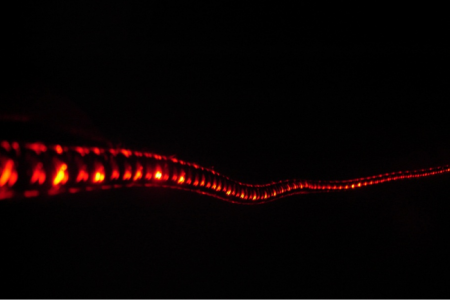
Fire Line par Thomas Buisson - Ligne guide pour sapeurs pompiers - 2010
BEN WALKER:
Was his presence useful to your team?
JEAN-BAPTISTE FLOCH:
It was. I think my fellow firemen were really glad that someone took an interest in their work. Thomas implemented workshops and discovery sessions that generated ideas and an exchange forum. We all learned a lot from him, and this made us look differently at our daily routine. Our worksite is great because it houses not only the emergency unit, but also the local logistics center. Having both of these in the same vicinity was a plus for Thomas, who soon decided to focus on the material side of our activities. That’s why I directed him toward our co-workers in Logistics who buy, maintain and fix the equipment, and to one in particular named Matthieu Lemoing, Head of Purchasing, who also volunteers as a fireman at the station. In a way, we could say that Thomas had two supervisors during this phase. Once the first step was completed, he declined two ideas, and proposed two new lines of work. We gave him advice, and as soon as his choices were set and he had firmly decided which material he was going to work on, I have to admit that my co-worker, Matthieu Lemoing, took over on the technical side of things, and supervised him on a full-time basis.
BEN WALKER:
Weren’t you a little surprised at how he found his lines of work? Did you feel as though he were acting in a logical manner?
Instant adjustment to a new environment
JEAN-BAPTISTE FLOCH:
In no time, Thomas settled into the rhythm of our profession, and become familiar with our work methods. My co-workers and I made good use of the on-line documents he had created, and all of us were sincerely impressed with how quickly he took to our techniques, the workings of our environments and our work ethic. He was surprisingly skilled for a novice. It usually takes us about a year to train a fireman. Thomas registered many things in only a few months Therefore he made concrete and feasible propositions based on his own research.
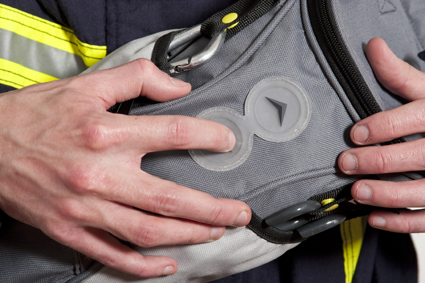
Fire Line - Thomas Buisson - 2010
BEN WALKER:
What were your impressions on Thomas’s final proposal, the Fire Line project?
JEAN-BAPTISTE FLOCH:
Thomas opted for one of his first two ideas, and focused on what we call the “life line,” allowing him to come up with innovative and functional ideas in response to user input and feedback. Retrospectively we must admit there was an unaddressed need because Thomas met with one of our industrial partners who grew particularly fond of his project. And this collaboration exceeded our expectations: their encounter spurred the industrial to hire Thomas first as in intern and then as an in-house designer. We really hope this project gives life to a product that can be beneficial to our staff on a daily basis.
BEN WALKER:
Thomas obtained a double degree in Business Management and Design in partnership with the Institute of Business Administration at the University of Nantes. Did you notice he had specific knowledge in Business and Management by the way he conducted his project?
JEAN-BAPTISTE FLOCH:
I guess he put his Management savvy into practice during the work sessions I was telling you about. His social skills enabled him to build strong ties with our team. He would come back to see what we were up to, update us and gather information on a regular basis. His personal qualities lent to him forging solid relationships.
BEN WALKER:
Thomas’s concept is close to becoming a marketable device. Maybe this will not happen right away, but the working prototype he recently made looks hopeful.
JEAN-BAPTISTE FLOCH:
Yes, yes, indeed. Between our first meeting when his project was still quite vague and the end result, I think the progress was startling for an outsider without any prior notions of the field. His approach was coherent from start to finish, including the: discovery phase, proposals and focus on one particular item all the way up to producing a prototype that will, hopefully, turn into a useful tool for firemen.
BEN WALKER:
Did you feel that Thomas, perhaps a bit shy initially and unsure of where he was going, gradually became more confident as he was working with you and your team, or would you say he was fully driven from the start?
JEAN-BAPTISTE FLOCH:
I am positive he was always truly motivated from the start, but…
BEN WALKER:
I’m asking this because, although we found his project promising, my fellow professors and I suggested he do a little bit of fieldwork, such as an internship or firefighter training. At first, I guess it was just him being shy as students can be. He was reluctant to do so. But once he got going, he had a lot of fun and enjoyed working with you and your team, and we could sense it in the way his project moved forward. He took to it more and more.
JEAN-BAPTISTE FLOCH:
Right, I won’t deny that he was not exactly convincing at first. Since he did not have a concrete project, I could have turned down his offer. But I wanted to give it a try. It was a new challenge for me. So Thomas and I gave it a shot, and he rose to the challenge. Looking back, I am really glad I agreed to be his supervisor. What he achieved for us was coherent right through to the end, and therefore, it warranted our support.
BEN WALKER:
Then, he prototyped Fire Line. Maybe one day there will be a Fire Line prototype here at SDIS 44?
JEAN-BAPTISTE FLOCH:
We’re still a long way from this day. I heard he completed a prototype, but we do not have it here at the station. Thomas updated us on a regular basis, and I hope his connections to the business world lead him to an interesting position. I think he’s on the right track with his job at Courant. We are awaiting the results of his final degree project. Those who dedicated time to Fire Line need to see the fruits of their labor in order to feel like it was time well-spent. Presenting the prototype and putting it at our disposal at the fire station would be a great way to illustrate the project.
Fire Line by Jocelyne Le Boeuf, Director of Studies
Life Line for Firemen – in sealed environments
Final degree project by Thomas Buisson
“I don’t think I could ever again work on a topic without totally immersing myself in its related environment”
To Thomas Buisson, a designer must immerse himself in real conditions and meet a variety of professionals and experts. That’s why, as part of a self-willed field investigation conducted prior to launching his final degree project he was an observer for more than a month at the Carquefou Fire Service Department, under the supervision of Captain Jean-Baptiste Floch, and took part in many different drills and training sessions. Then he furthered his observation of the many working methods implemented at CTA-CODIS 44 (the local Fire and Emergency Services Department) with a comparative study of the equipment used in the many fire stations of the area. He gained a very comprehensive overview of the wholesalers during a one-day national firemen convention held in Saint-Étienne (Eastern France) in 2009.
But what helped Thomas Buisson understand what a designer could contribute in this context are first and foremost his social skills and his hands-on abilities. He even initiated creativity sessions with firemen, which prompted more or less realistic lines of work such as: “see-through walls,” “predicting accidents,” “having several arms,” “breathing trough smoke without a respiratory device.”
A simple and sturdy device that can been in the dark…
Among the many fields of action covered by firemen, Thomas Buisson eventually decided to focus his project on hostile fires. Hostiles fires amount to 9 % of fire service interventions but offer a “significant field of action for designers.” The young designer in-the-making had the opportunity to identify a series of issues raised by the “life line,” a device designed for a two-men team already out there at the front to find their way through the fire and smoked up environment: this material is heavy-duty and oftentimes makes it hard for the two-men teams to meet their peers’ path. Though more than necessary for exchanging information in such risky environments, the radio contact can sometimes be disrupted by the surrounding noise.
The project carried out by Thomas Buisson – Fire Line – materializes as a carrying bag that houses a lightweight – 2 kg instead of the usual 15 kg – and luminescent “life line.” The carrying bag can be slung over the shoulder and kept at hand’s reach for optimum control of the line’s unwinding speed. The bag features a communication system based on radio wave-transmitted light signals. His designer’s research also included selecting relevant materials: non-flammable fire-resistant fibers (Kermel) for the carrying bag, copper, aramid fiber and silicon for the rope, translucid polycarbonate for the olive-shaped markers placed every 10 meter on the rope so that firemen can keep track of the distance walked.
Fire Line could also be implemented in other fields such as spelunking/speleogy or deep-sea diving.
Looking ahead: partnerships and networks
Thomas Buisson prepared a Master’s in Business Management (a double curriculum based on a partnership between L’École de design Nantes Atlantique and the Nantes Business Administration Institute). The knowledge gained during this management-oriented training equipped him with sufficient skills to address his project with a truly economic dimension and to knit fruitful contacts with equipment manufacturers. All throughout the advancement of his project, the young designer has built up a reliable professional network. So much so that his collaboration with French company Courant – an innovative company specializing in a specific range of professional materials) paved the way to a patent deposit and to a working prototype.
Who is Jean-Baptiste Floch?
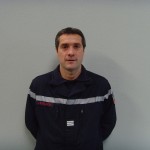 Capitaine Jean-Baptiste FLOCH has worked as a firefighting officer since 1991. From 1991 to 2001, he was in practice in Toulouse (Southern France). In 2003, he was appointed Head of the Carquefou Fire and Emergency Services in the vicinity of Nantes (Loire region). The Carquefou fire station counts 3 officers, 30 professional firemen and 60 trained volunteers. This unit covers Carquefou and its neighboring towns, which amounts to roughly 60, 000 inhabitants in total.
Capitaine Jean-Baptiste FLOCH has worked as a firefighting officer since 1991. From 1991 to 2001, he was in practice in Toulouse (Southern France). In 2003, he was appointed Head of the Carquefou Fire and Emergency Services in the vicinity of Nantes (Loire region). The Carquefou fire station counts 3 officers, 30 professional firemen and 60 trained volunteers. This unit covers Carquefou and its neighboring towns, which amounts to roughly 60, 000 inhabitants in total.
Read also:
A Year in Responsible Innovation by Thomas Buisson [Read more →]
Tags: · ben walker, fireline, fire, responsible innovation, safety, firemen, thomas buisson, emergency
Posted by m.saysana
Sébastien Genvo is an expert in game design who has tenure as an Assistant Professor at Paul Verlaine University in Metz (France). Here are his anwers to a bunch of questions asked by Thierry Lehmann, Head of the research unit in Tangible Interfaces of L’École de design Nantes Atlantique. Their conversation is centered on augmented reality and vidéo games seen as means of expression and of questionign reality. Thierry Lehmann introduces us to Immersive Rail Shooter an application developed as part of a final degree project by David Arenou, with the keen support of his tutor, Sébastien Genvo. IRS was awarded several prizes at most renowned Japanese competitions IVRC and Siggraph 2010.
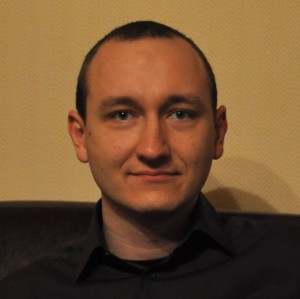
Sébastien Genvo, Assistant Professor at the University Paul Verlaine in Metz (France) - game design expert
[Read more →]
Tags: · david arenou, game design, interaction, interface, tangible interfaces, nui, augmented reality, virtual reality
Posted by m.saysana
Pascal Gentil, Head of the Technical Department at the Innovathèque – a French resource center for innovative materials – is an expert in innovative materials. He supervised the éKosse project devised by Caroline Saier, Master’s student in the Mutations of the Built Environment Program. Catherine Bouvard, Curriculum Course Leader, asked Pascal Gentil about the activities offered at the Innovathèque, current issues involving materials and the interaction between this field and design.

Pascal Gentil, Head of the Technical Department at the Innovathèque
[Read more →]
Tags: · caroline saier, catherine bouvard, durable, industrie, innovation, matériau, mémoire de forme, furniture, mutations of the built environment
Posted by m.saysana
In October 2009 Christian Guellerin, Managing Director of L’École de design spoke at the symposium organized by the International Association of Societies of Design Research in Seoul. Upon his return he brings to the fore the dos and don’ts of research in design and what it must do to grow into a true scientific discipline…
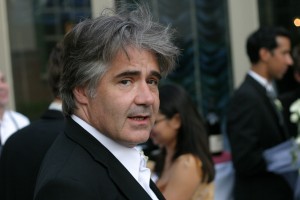
I have recently given a lecture at the symposium organized by the IASDR – “International Association of Societies of Design Research” 2009* – a research-oriented conference presenting the work of a large number of researchers and universities from all over the world. Many vibrant debates took place and much knowledge was produced during this wide-scoped event.
However I was puzzled by such a profusion of information about “research” and “design”, two terms many of us are striving to bring closer.
In doing so we must be wary not to bite our own tail like business schools, who call “marketing research” quantitative or qualitative studies often limited to statistic charts interpreted in a not-so-scientific manner that lacks the method and depth of sociological research. Why naming “marketing research” activities that are no more and no less than the very practice of “marketing”?
Why naming “design research” all reflections about creation and innovation?
Can design be recognized as a full-fledged scientific discipline?
Design is but an emerging discipline that is not very visible yet in the field of research. Some take advantage of this state of things to engage in studies pertaining to sociology, psychology, educational theory or hard sciences and claim they are doing “design research.” To me this working method is irrelevant and will not help design be accepted as a research discipline.
Along the same line using the term “design research” to refer to projects carried out by professionals does not seem very relevant to me either.
The central issue of this debate is the very nature of design. Can design, as a practice, really be defined as a science? The criteria to answer this question have not been decided upon yet. And it harms the image of “design research” to rank behind this label initiatives stemming from other disciplines, innovation-oriented initiatives, or new production processes applied to products developed according to the usual methods.
We must be cautious here. Otherwise we run the risk of blurring the message conveyed by a young discipline – design – still in the process of defining its very identity and of proving its legitimacy on the academic level. Doing “debased” sociology, or debased psychology to try and codify “design-induced emotions” is not a serious way of tackling the issue.
We must aim at centering research on a specific unique field based on a language of representation and on an interface linking all the knowledge produced by human sciences or hard sciences with the social and economical issues ruling the world we live in. Design is a language and an interface that brings human beings, ideas and knowledge together to shape a better world for tomorrow.
If we want to promote design as a science we must beware not to mix everything up just because design is all over the place and because conducting activities involving reflection makes one feel important.
Christian Guellerin, Managing Director of L’École de design.
[Read more →]
Tags: · christian guellerin, colloque, design, iasdr, innovation, research
Posted by m.saysana
Interview with Jean-Jacques Boutaud, semiotician
Since 2008, CADI has investigated the field of knowledge transfer by interviewing experts who agreed to supervize fifth-year students in carrying out their final degree projects. This is an effort to build up a corpus of testimonies to come to a better understanding of the collaborative and representative methods resorted to by innovation and creation players, taking into account economic, cultural and evrironmental trends. In March 2010, we evolved the print issues into an electronic…
Jean-Jacques Boutaud teaches Communications at the University of Burgundy and is an expert in semiology and semiotics. He is particularly interested in the art of dining and has written a series of books exploring the link between semiotics and communication. He is in charge of a research laboratory dedicated to communication within the sensible universe, and his team focuses on documenting topics such as image, mediation and the notion of sensibility in information and communication-oriented initiatives (LIMSIC).

1001 saveurs - final degree project by Morgane Bily, carried out with the help of Jean-Jacques Boutaud, 2008-2009
[Read more →]
Tags: · taste, jean patrick péché, new eating habits, semiology, semiotics
Posted by m.saysana
Interview with Thomas Bottini, researcher in computer science for music
“Knowledge Transfer(s): the interviews
Since 2008, CADI has investigated the field of knowledge transfer by interviewing experts who agreed to supervize fifth-year students in carrying out their final degree projects. This is an effort to build up a corpus of testimonies to come to a better understanding of the collaborative and representative methods resorted to by innovation and creation players, taking into account economic, cultural and evrironmental trends. In March 2010, we evolved the print issues into an electronic…
Thomas Bottini holds a degree in computer engineering from the Technological University of Compiègne (France). In parallel to his engineering training, he studied human sciences and the philosophy of artistic creation-related content. His current research into creating tools for the advanced reading and writing of multimedia documents demonstrates his keen interest in studying the relationship between digital technology and artistic creation. To further study this link, he has worked in collaboration with musicologists from the IRCAM (French institute of research and musical/acoustic coordination) to develop as a cross-disciplinary team a multimedia environment dedicated to musical analysis. In 2006 he created a tool to help organize musical analysis in tables (Musique Lab Annotation).

MUE - Auréien Pasquier's final degree project carried out with the help of Thomas Bottini, 2008-2009
[Read more →]
Tags: · computer science for music, interface, smart interface, tangible interfaces, CAM, musical science













